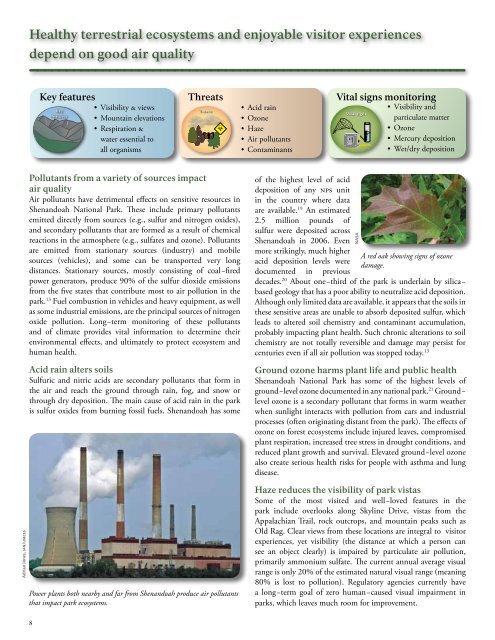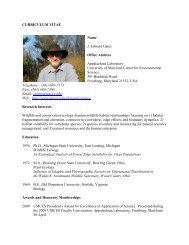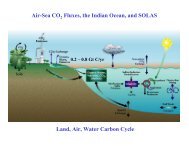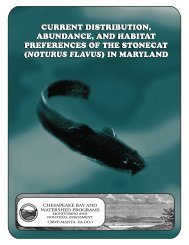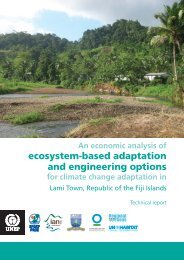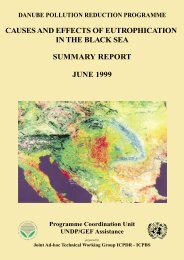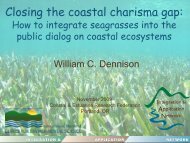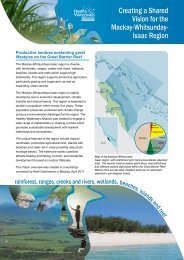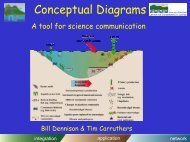Shenandoah National Park - Integration and Application Network
Shenandoah National Park - Integration and Application Network
Shenandoah National Park - Integration and Application Network
- No tags were found...
Create successful ePaper yourself
Turn your PDF publications into a flip-book with our unique Google optimized e-Paper software.
Healthy terrestrial ecosystems <strong>and</strong> enjoyable visitor experiencesdepend on good air qualityKey featuresKeyfeatures• Visibility & views• Mountain elevations• Respiration &water essential toall organismsThreatsThreats• Acid rain• Ozone• Haze• Air pollutants• ContaminantsVital signs monitoring• Visibility <strong>and</strong>Vital signsparticulate matter• Ozone• Mercury deposition• Wet/dry depositionAdrian Jones, IAN/UMCESPollutants from a variety of sources impactair qualityAir pollutants have detrimental effects on sensitive resources in<strong>Shen<strong>and</strong>oah</strong> <strong>National</strong> <strong>Park</strong>. These include primary pollutantsemitted directly from sources (e.g., sulfur <strong>and</strong> nitrogen oxides),<strong>and</strong> secondary pollutants that are formed as a result of chemicalreactions in the atmosphere (e.g., sulfates <strong>and</strong> ozone). Pollutantsare emitted from stationary sources (industry) <strong>and</strong> mobilesources (vehicles), <strong>and</strong> some can be transported very longdistances. Stationary sources, mostly consisting of coal−firedpower generators, produce 90% of the sulfur dioxide emissionsfrom the five states that contribute most to air pollution in thepark. 13 Fuel combustion in vehicles <strong>and</strong> heavy equipment, as wellas some industrial emissions, are the principal sources of nitrogenoxide pollution. Long−term monitoring of these pollutants<strong>and</strong> of climate provides vital information to determine theirenvironmental effects, <strong>and</strong> ultimately to protect ecosystem <strong>and</strong>human health.Acid rain alters soilsSulfuric <strong>and</strong> nitric acids are secondary pollutants that form inthe air <strong>and</strong> reach the ground through rain, fog, <strong>and</strong> snow orthrough dry deposition. The main cause of acid rain in the parkis sulfur oxides from burning fossil fuels. <strong>Shen<strong>and</strong>oah</strong> has somePower plants both nearby <strong>and</strong> far from <strong>Shen<strong>and</strong>oah</strong> produce air pollutantsthat impact park ecosystems.of the highest level of aciddeposition of any NPS unitin the country where dataare available. 19 An estimated2.5 million pounds ofsulfur were deposited across<strong>Shen<strong>and</strong>oah</strong> in 2006. Evenmore strikingly, much higheracid deposition levels weredocumented in previousNASAA red oak showing signs of ozonedamage.decades. 20 About one−third of the park is underlain by silica−based geology that has a poor ability to neutralize acid deposition.Although only limited data are available, it appears that the soils inthese sensitive areas are unable to absorb deposited sulfur, whichleads to altered soil chemistry <strong>and</strong> contaminant accumulation,probably impacting plant health. Such chronic alterations to soilchemistry are not totally reversible <strong>and</strong> damage may persist forcenturies even if all air pollution was stopped today. 13Ground ozone harms plant life <strong>and</strong> public health<strong>Shen<strong>and</strong>oah</strong> <strong>National</strong> <strong>Park</strong> has some of the highest levels ofground−level ozone documented in any national park. 21 Ground−level ozone is a secondary pollutant that forms in warm weatherwhen sunlight interacts with pollution from cars <strong>and</strong> industrialprocesses (often originating distant from the park). The effects ofozone on forest ecosystems include injured leaves, compromisedplant respiration, increased tree stress in drought conditions, <strong>and</strong>reduced plant growth <strong>and</strong> survival. Elevated ground−level ozonealso create serious health risks for people with asthma <strong>and</strong> lungdisease.Haze reduces the visibility of park vistasSome of the most visited <strong>and</strong> well−loved features in thepark include overlooks along Skyline Drive, vistas from theAppalachian Trail, rock outcrops, <strong>and</strong> mountain peaks such asOld Rag. Clear views from these locations are integral to visitorexperiences, yet visibility (the distance at which a person cansee an object clearly) is impaired by particulate air pollution,primarily ammonium sulfate. The current annual average visualrange is only 20% of the estimated natural visual range (meaning80% is lost to pollution). Regulatory agencies currently havea long−term goal of zero human−caused visual impairment inparks, which leaves much room for improvement.8


